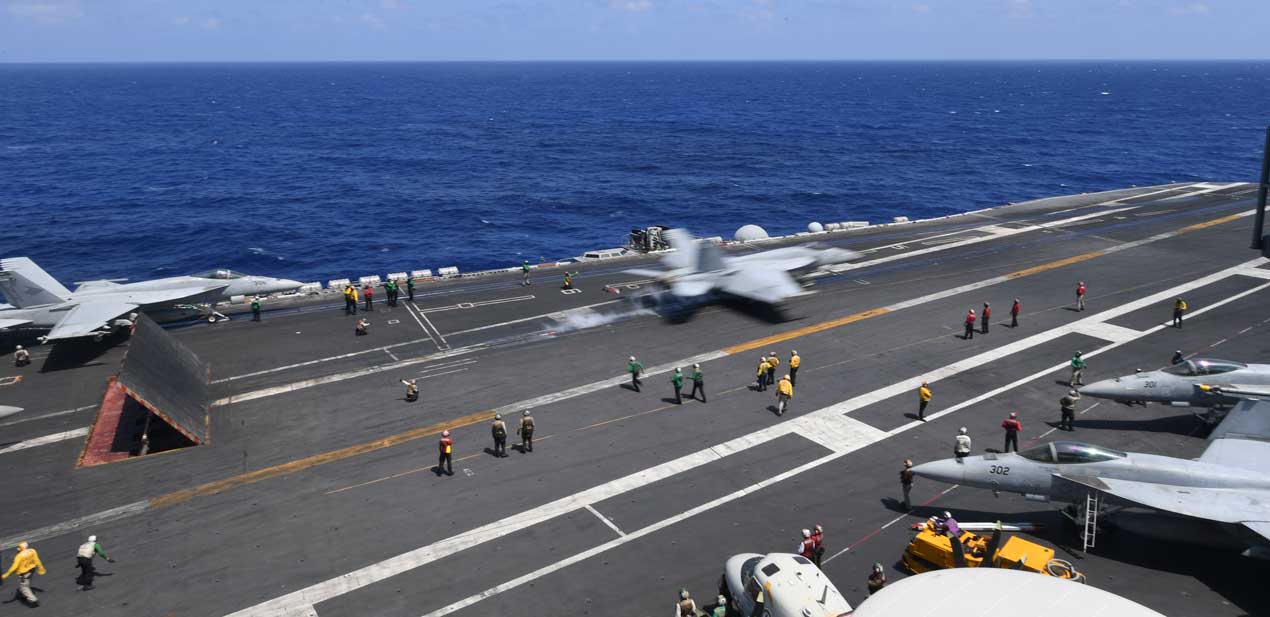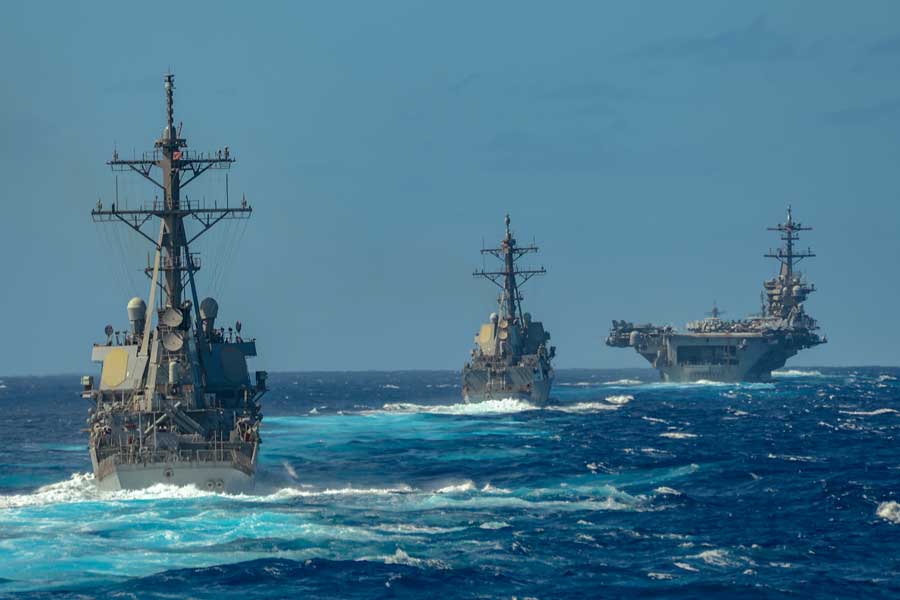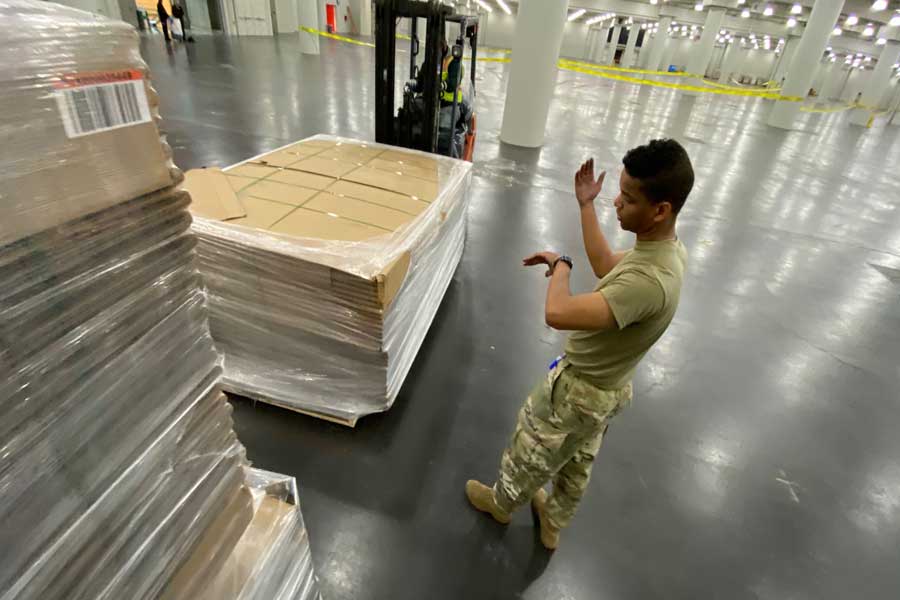US Sailor Dies From COVID-19
A sailor on board the US Navy's Theodore Roosevelt carrier has died from COVID-19.
14 April 2020
 The flight deck of the aircraft carrier USS Theodore Roosevelt March 19, 2020. The Theodore Roosevelt Carrier Strike Group was on a scheduled deployment to the Indo-Pacific at the time of the coronavirus outbreak. (US Navy photo by Mass Communication Specialist 2nd Class Pyoung K. Yi)
The flight deck of the aircraft carrier USS Theodore Roosevelt March 19, 2020. The Theodore Roosevelt Carrier Strike Group was on a scheduled deployment to the Indo-Pacific at the time of the coronavirus outbreak. (US Navy photo by Mass Communication Specialist 2nd Class Pyoung K. Yi)
CORONAVIRUS AT SEA
First US Navy sailor dies from COVID-19
A coronavirus outbreak on board the US Navy's Theodore Roosevelt aircraft carrier has claimed the life of a sailor. The sailor, who has since been identified as Aviation Ordnanceman Chief Petty Officer Charles Robert Thacker, was admitted to the Intensive Care Unit (ICU) of the US Naval Hospital in Guam on April 9 (local date), but later died of COVID-related complications on April 13. The death is the first among the crew after 600 tested positive for the virus.
According to an official statement by the US Navy, the sailor tested positive for COVID-19 on March 30 and was removed from the ship and placed in an isolation house on Naval Base Guam with four other USS Theodore Roosevelt sailors. He received medical checks twice daily from Navy medical teams. At approximately 8:30 am on April 9, the Navy said the sailor was found unresponsive during one of these checks. While Naval Base Guam emergency responders were notified, CPR was administered by fellow sailors and onsite medical teams in the house.
The Nimitz-class nuclear powered aircraft carrier with 5,000 crew members was forced to dock in Guam on March 27 after eight sailors with mild symptoms (muscle aches, sore throats) tested positive for COVID-19 and were airlifted off the ship to a Defense Department facility in Guam.
Once the ship pulled into Guam the entire crew were tested. Anyone testing positive for the virus was quarantined at a naval medical facility on the island. Reuters reported that 12% of the crew on board (600) the vessel have since tested positive for COVID-19. The US Navy says crew members who tested positive for COVID-19 remain in isolation at controlled locations on Naval Base Guam, where they receive daily medical supportive care. All medical care is being provided by medical personnel from USS Theodore Roosevelt, US Naval Hospital Guam, and elements of the US Marine Corps 3rd Medical Battalion.
At the time of the outbreak on board the carrier, former Acting Navy Secretary Thomas B. Modly maintained that the Theodore Roosevelt was operationally capable and able to do its mission if required to do so. But the carrier's Commander, Captain Brett Crozier, who also tested positive for coronavirus, called on the the Navy to do more by evacuating the bulk of the crew and cleaning the ship. “We are not at war. Sailors do not need to die. If we do not act now, we are failing to properly take care of our most trusted asset - our sailors,” Capt. Crozier wrote in an official letter that was leaked to the press.
The letter cost him his job. Capt. Crozier was relieved of his command on April 2 by Modly, who flew especially to the port in Guam where the vessel was docked to give the commander his marching orders. Modly came under criticism after berating Crozier and treating the ship's crew disrespectfully. Modly, who later resigned from his post, is said to have been angered by videos posted on Twitter showing the carrier's crew members clapping and cheering, 'Captain Crozier,' as he disembarked from the ship for the last time.

US Navy Capt. Brett Crozier (right), former commanding officer of the aircraft carrier USS Theodore Roosevelt with Capt. Pete Riebe, executive officer of Theodore Roosevelt: Capt. Crozier was relieved of his position after writing a letter asking the Navy to do more to save personnel on board the stricken vessel. (US Navy photo by Mass Communication Specialist Seaman Kaylianna Genier)
The USS Theodore Roosevelt was on operations in the Philippine Sea at the time of the outbreak. Navy Admiral Michael Gilday, Chief of Naval Operations, said the vessel made a port call in Vietnam 15 days prior to the outbreak on board, and after leaving Vietnam spent 14 days in isolation. “It would be difficult to tie down active cases to that particular port visit,” he stated at a Pentagon press briefing on the 24 March. “We had aircraft flying to and from the ship. Crew came back from shore.” The Navy had COVID-19 and influenza testing capabilities on board the aircraft carrier.
Despite the spread of the virus amongst serving personnel, the Navy maintains that military operations are continuing as normal.
Other incidents of coronavirus on board naval vessels have been reported. On March 26, Russian news site, b-port.com, cited a source familiar with the situation stating that the entire crew of a Russian Oscar-II class submarine missile cruiser, part of Russia's Northern Fleet, had been quarantined after a civilian operator, who had visited the submarine, came into contact with someone who tested positive for the virus. On March 30, Forbes reported that a Dutch submarine was forced to return to base after eight crew on board developed symptoms.
Clive Murgatroyd MBE, a Lecturer in Capability Management and Defence Acquisition for Cranfield Defence and Security, Shrivenham, and a former naval officer, said it would be virtually impossible for crew members to self isolate on board a naval vessel. “Working and living on board a ship entails being right alongside your colleagues most of the time,” he explains. “For example, in the operations room you are sitting next to each other, all doing important jobs. You have shared bathrooms, you eat together, social distancing would be very difficult.”
Even in the Royal Navy's newest vessels, Murgatroyd says you would typically have 6 ratings in each sleeping area. The ventilation system on board, he says, adds to the problem, by making it easier for things like common colds and flu to spread among crew members.
“Everyone on board has a job to do, which means if you're short one or two people those jobs don't get done, or others have to stand in," says Murgatroyd. "If you are in a two watch system and you lose someone, how do you fill the gap?"
A UK Ministry of Defence spokesperson said the MoD had put in place plans to ensure the delivery of its key operations in the UK and overseas and that the Royal Navy will continue to conduct essential training ashore and at sea in order to fulfil operational outputs now and in the future. “We continue to conduct sensible and proportionate planning to ensure the welfare of our personnel is protected, while maintaining essential operational duties,” the spokesperson stated.
RELATED ARTICLES
Navies Wrestle With Coronavirus

Fighting An Invisible Enemy
